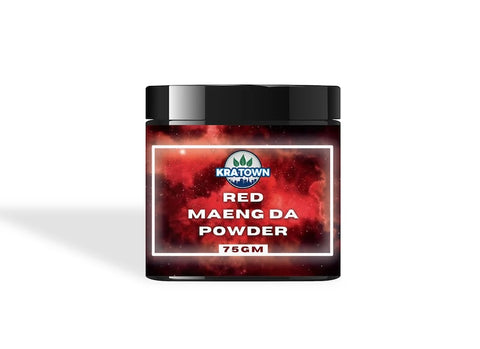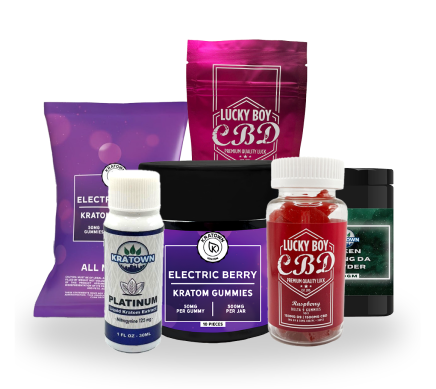
The Real Meaning Behind Kratom’s Colors
If you’ve ever wondered why kratom strains sometimes sound like they’re straight out of a paint swatch catalog, you’re not alone.
When you’re shopping around in herbal stores or online, you’ll find that kratom powders, capsules, gummies, and all those other products come in red, green, white, and something called “trainwreck.”
And if you’ve done your research before hitting the stores, you’ve probably read that all the different colors have different effects ranging from sedation to stimulation—could it be so?
To really understand kratom, you have to get to know its colors—where they come from, what they mean, and the difference they make.
The Color Breakdown
Sadly, kratom leaves don’t magically change colors like a mood ring—though that would be very cool. Instead, their color names just refer to the vein patterns on the underside of the kratom leaf. Still neat, right? We’ll take what we can get.
What may be even more surprising is that your white, green, and red kratom could all come from the same tree. That’s because the color comes from the age of the leaves rather than the type of tree they come from.
So, of course, white kratom comes from leaves with white veins, which means that the tree is young. Green kratom comes from veins that blend right in with the kratom tree’s medium green leaf color as the tree matures. Red comes from leaves with red or even brown-hued veins, indicating the tree’s older age.
Oh, and by the way, that curious-sounding trainwreck kratom variety? It’s not so mysterious after all. It’s just a greenish-brownish mix of all three colors together—like the wild family reunion of kratom strains.
And it goes without saying—but we’ll say it anyway—factors like soil type, genetics, nutrient absorption, and sunlight can influence the vibrancy of these colors. After all, kratom is still a plant, so not every batch you get will look or act the same. It’s all just a part of the charm.
Drying Makes the Difference
Most people don’t consume fresh leaves straight from trees. Instead, they buy the dried leaves or a better-tasting kratom product like liquid kratom extract, gummies, or powder.
Kratom manufacturers use processed leaves to make those products. And while kratom’s veins give it its initial color, it’s actually the treatment it receives post-harvest that determines its final hue.
White kratom is typically dried in a cool room indoors and not exposed to sunlight. The kratom producer dries the green stuff in a dark, air-conditioned room and then exposes it to light for just a little bit—like an hour.
The treatment of red kratom is the most unique. Producers ferment it in bags and expose it to the most sunlight, both of which create its dark hue.
So, it turns out, the secret to kratom’s color isn’t magic—just some sunbathing, indoor chilling, and post-drying spa treatments. Sounds pretty nice.
All About the Alkaloids
Now, what you’re really wondering is whether it matters which kind you buy. Will you feel more energized if you buy the red stuff? Or calmer if you snag a little of the white?
Not according to one study that looked at the difference kratom has on your psychoactive state. These researchers surveyed kratom consumers, asking them to self-report kratom’s effects and their reasoning for selecting any given color.
They also studied samples of the kratom varieties and their alkaloid contents. The alkaloids mitragynine and 7-hydroxy mitragynine are the active ingredients in kratom that produce its reported effects of stimulation or sedation. In their work, the researchers found no significant differences between the strains in terms of alkaloid content. That means that since the alkaloids are the same, the effects should be, too.
So, spoiler alert: whether it’s red, green, white, or trainwreck, kratom’s chemical makeup stays as consistent as your playlist on repeat.
Why People Feel It Differently
You may think, “There’s no way that’s true.” How can so many people swear that different kratom colors have totally unique effects on them?
Well, the truth is, much of what we hear about kratom’s distinct effects could be shaped a lot by word-of-mouth and some clever marketing rather than actual differences in the plant itself. People tend to believe what they’ve been told—especially when it’s tied to personal stories or catchy descriptions.
It would be interesting for future studies to conduct blind experiments. Without knowing which strain they’re taking, would people still report these distinct effects? Many of these experiences may be more of a placebo effect than an actual difference in the kratom’s makeup.
Does It Really Matter?
In the end, no, the color of kratom doesn’t make much difference. Whether it’s red, green, white, or the trainwreck mix, the effects will probably be about the same. So don’t stress too much over picking the “right” one—just choose whatever looks good to you and enjoy it for what it is.
Disclaimer: The information in this article is for educational purposes only. Please consult a healthcare provider for specific medical advice. Kratom use may carry potential risks. Please determine if kratom is legal in your area before purchasing and consuming it.

